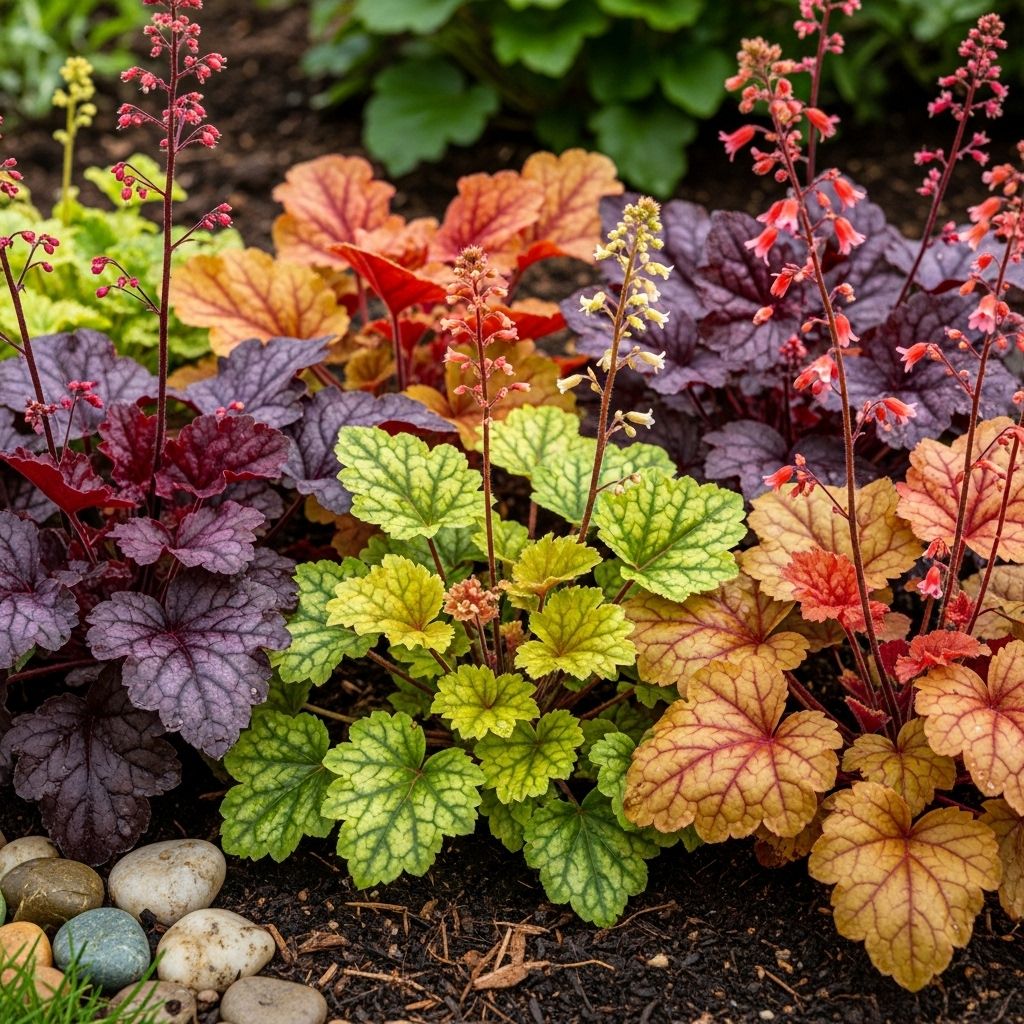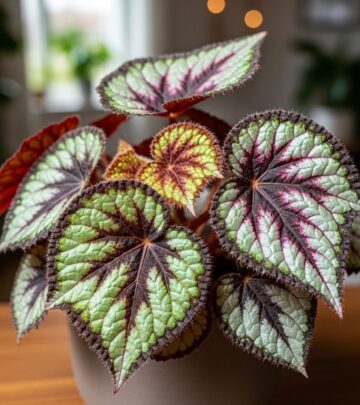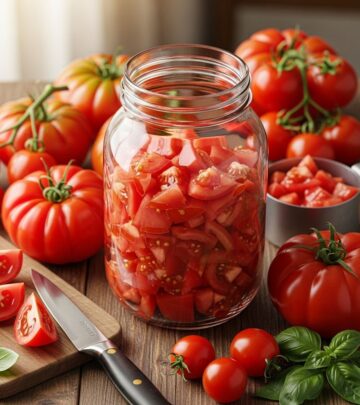How To Grow Coral Bells: A Complete Guide For Thriving Heuchera
Coral bells deliver vibrant foliage, multi-season interest, and effortless care for both garden beds and containers.

Image: HearthJunction Design Team
Coral Bells (Heuchera): A Complete Guide
Coral bells (Heuchera spp.) have earned their spot as a garden favorite, dazzling with vibrant, sculptural foliage and sending up elegant flower spikes for months. Native to North America and now bred into hundreds of show-stopping varieties, coral bells combine multi-season impact, straightforward maintenance, and versatile uses in modern landscapes and containers.
Whether you want to brighten up a shady corner, create eye-catching container arrangements, or add pollinator-friendly blooms, coral bells deliver drama and durability for gardeners of every level.
On this page:
- Coral Bell Basics
- Planting and Growing Coral Bells
- Coral Bells Care
- Popular Coral Bells Varieties
- Ideas for Using Coral Bells in the Garden
- Frequently Asked Questions
Coral Bell Basics
| Attribute | Details |
|---|---|
| Common Names | Coral bells, alumroot, rock geranium |
| Botanical Name | Heuchera spp. |
| Family | Saxifragaceae |
| Plant Type | Perennial |
| Mature Size | 8–18 inches tall, 12–24 inches wide |
| Sun Exposure | Partial to full shade; some tolerate full sun |
| Soil Type | Rich, moist, well-drained |
| Soil pH | Acidic to neutral |
| Bloom Time | Late spring to early summer |
| Flower Colors | Red, pink, white, orange |
| Hardiness Zones | USDA 4–9 |
| Native Area | North America |
Cultivated coral bells bear brightly colored, often ruffled or veined foliage in hues from silvery green to burgundy, chartreuse, and nearly black. In late spring and summer, slender stems rise above the foliage carrying clusters of bell-shaped flowers that attract hummingbirds and pollinators.
Planting and Growing Coral Bells
Coral bells thrive in a range of environments, including woodland shade, prairies, and even rock gardens. Thanks to extensive breeding, there are cultivars suited for most gardens—sun or shade, moist or dry.
Where to Plant Coral Bells
- Light: Most coral bells prefer partial shade, especially in hotter climates. Some varieties with darker foliage handle more sun, while lighter or variegated types may need protection from strong afternoon rays.
- Soil: Rich, well-drained, and consistently moist soil is ideal. Avoid heavy clay or boggy spots. Mulch helps conserve moisture but avoid piling it against stems.
- Spacing: Space plants 12–24 inches apart, depending on variety, to accommodate their mature spread.
Tip: Coral bells can also thrive in containers with well-draining potting mix.
How to Plant Coral Bells
- Timing: Plant coral bells in early spring after last frost or in early fall while the soil is still warm for best establishment.
- Preparation: Amend soil with compost to improve drainage and fertility. Loosen soil to at least 8 inches deep.
- Planting: Place plants at the same depth they grew in their nursery pots. Firm soil around the roots and water thoroughly.
- Mulching: Apply a 2-inch layer of organic mulch to retain soil moisture, moderate temperature, and reduce weeds. Keep mulch several inches away from crowns.
Companion Planting
- Coral bells pair beautifully with hostas, ferns, astilbes, Japanese forest grasses, and brunnera, creating layered shade beds.
- They also blend well with sun-friendly perennials in mixed borders or containers.
Coral Bells Care
Coral bells are low maintenance but benefit from a few basic care steps to look their best and live long lives.
Watering
- Keep soil consistently moist, especially during the first season and hot spells, but avoid waterlogging.
- Once established, most varieties tolerate mild drought but grow best with even moisture.
Feeding
- Feed in spring with a balanced slow-release fertilizer if your soil is lean, or use a light side-dressing of compost.
- Too much fertilizer (especially high-nitrogen types) can weaken the plants.
Pruning & Clean-Up
- Prune away any winter-damaged or tattered foliage in early spring to encourage healthy new leaves.
- Deadhead spent flowers to prolong bloom and neaten appearance.
- Divide crowded clumps every 3–4 years in spring or early fall to rejuvenate plants and prolong vigor.
Pests & Problems
- Heucheras are generally pest resistant but may rarely encounter foliar nematodes, vine weevils, or rust.
- Good air circulation and well-drained soil help prevent issues.
Winter Care
- Coral bells are mostly evergreen in mild climates. In colder areas, a light mulch protects crowns from freeze-thaw cycles.
- Remove heavy mulch in spring to discourage rot.
Popular Coral Bells Varieties
With hundreds of selections available, coral bells come in nearly every color and form imaginable. Here are a few outstanding choices:
- ‘Peach Flambé’: Leaves shift from peachy-orange in spring to plum-red in fall; compact and vigorous.
- ‘Palace Purple’: Classic with deep burgundy-purple foliage; an RHS Award of Garden Merit winner.
- ‘Lime Rickey’: Vibrant chartreuse leaves; tolerant of heat and humidity.
- ‘Caramel’: Apricot-toned leaves with a soft, velvety texture.
- ‘Black Pearl’: Broad, jet-black leaves; dramatic in shade or part sun.
- ‘Silver Scrolls’: Silvery, veined foliage with maroon undersides.
- ‘Fire Chief’: Bright red leaves and a tidy mounding habit; persists through multiple seasons.
New introductions continue to offer ever more vibrant leaf colors, improved sun tolerance, and longer-lasting blooms, making it easy to find a perfect fit for every garden.
Ideas for Using Coral Bells in the Garden
Coral bells’ versatility means they can fill many roles in today’s landscape. Here are some design ideas:
- Accent in Shade Gardens: Layer contrasting leaf shapes and hues with hostas and ferns.
- Colorful Edging: Use compact varieties for borders, paths, or as groundcovers.
- Container Star: Combine several varieties or pair with trailing plants for stunning year-round pots.
- Woodland Drifts: Mass in naturalistic sweeps beneath deciduous trees for an easy-care tapestry.
- Rock and Crevice Gardens: Choose smaller selections to edge stones or fill gaps.
- Pollinator Gardens: Heuchera blooms attract hummingbirds and beneficial insects.
- Mixed Perennial Beds: Mix with hellebores, astilbe, and brunnera for succession of flowers and foliage texture.
Pro tip: Use colored foliage to bridge flowering seasons and maintain garden interest even when blooms are scarce.
Frequently Asked Questions (FAQs)
Q: How long do coral bells live?
A: Coral bells are considered short-lived perennials, usually thriving for 3–4 years before declining. Dividing clumps every few years helps extend their lifespan and vigor.
Q: Can coral bells grow in full sun?
A: Some newer varieties with darker foliage tolerate full sun, especially in cooler climates. Most, however, prefer partial shade. Lighter-leaved types can bleach in strong sun and benefit from afternoon shade, particularly in hot regions.
Q: Are coral bells deer resistant?
A: Coral bells are moderately deer resistant; their thick, tough leaves deter browsing compared to more succulent plants.
Q: Do coral bells spread?
A: Coral bells form tidy mounds rather than spreading aggressively. Over time, healthy clumps increase in width and can be divided to create new plants.
Q: When should I divide coral bells?
A: Divide every 3–4 years in early spring or early fall. Replant the healthiest sections and discard woody or weak centers.
Summary Table: Coral Bells at a Glance
| Feature | Benefit |
|---|---|
| Foliage Color | Burgundy, lime, bronze, purple, silver, black, peach, and more |
| Flowering | Bell-shaped blooms in late spring-summer; attracts pollinators |
| Pest Resistance | Deer and rabbit resistant; few pest issues |
| Uses | Borders, shade gardens, containers, groundcover, pollinator gardens |
| Maintenance | Low; occasional division and deadheading |
Conclusion
Coral bells have evolved from humble woodland natives into indispensable, high-impact perennials for gardens and containers of all styles. Their extraordinary foliage, easy-care nature, and adaptability make them a perennial favorite among gardeners eager to add long-lasting color and texture to their outdoor spaces. With new varieties introduced each year, there has never been a better time to explore the dazzling world of Heuchera.
References
- https://www.thespruce.com/growing-coral-bells-heuchera-1402032
- https://www.gardendesign.com/perennials/coral_bells.html
- https://www.bhg.com/gardening/plant-dictionary/perennial/coral-bells/
- https://www.gardenersworld.com/how-to/grow-plants/how-to-grow-heucheras/
- https://www.masterclass.com/articles/coral-bells-plant-guide
Read full bio of medha deb












